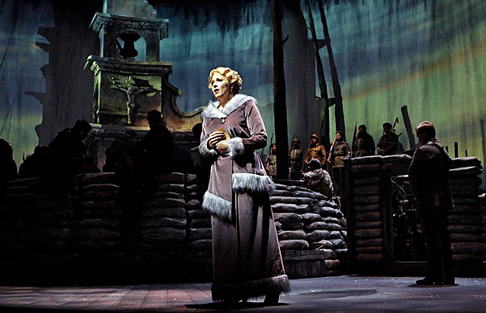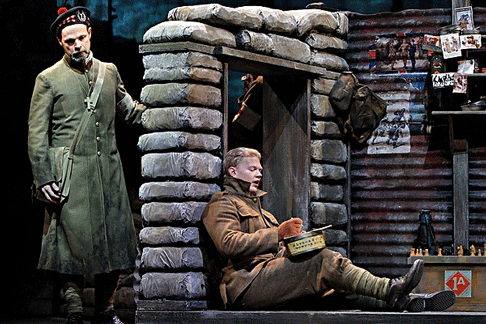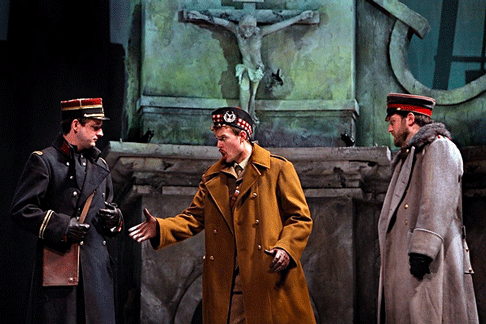06 Dec 2011
Silent Night, Minnesota Opera
At the November 12, 2011 world premiere of Silent Night at the Ordway Theatre in St. Paul, a buzz of energy filled the audience.

At the November 12, 2011 world premiere of Silent Night at the Ordway Theatre in St. Paul, a buzz of energy filled the audience.
Silent Night had been highly anticipated in the Twin Cities for over the past year, which the company had work-shopped the opera with its Resident Artist singers, tweaking vocal parts, shoring up orchestral textures, as well as readying the Minnesota Opera’s fan base for a different kind of opera outside of its more traditional programming. Anticipation was also high for this particular performance, as only the Opera Company of Philadelphia had contributed to the commission, and several representatives of interested companies were in the audience to scout this opera for their prospective seasons.
Based upon a true World War I story, Christian Carion’s 2005 film Joyeux Noël, depicted an incident during World War I near the French border. Three encampments, Scottish, French and German, encircled a battlefield. After bloody fighting, soldiers called an unofficial truce for Christmas day, 1914. The film’s compelling message of religious unity and the commonality of the human condition, all in the midst of waging war, inspired Dale Johnson, artistic director of the Minnesota Opera, to commission Kevin Puts to translate the film into operatic form.
Silent Night is Puts’s first opera, though his career boasts a variety of orchestral and chamber works commissioned and performed by leading orchestras, ensembles and soloists throughout North America, Europe and the Far East. Johnson provided Puts with significant dramaturgical support partnering the composer with veteran librettist Mark Campbell and director Eric Simonson. “Eric’s not only a wonderful director, he’s an accomplished writer himself,” Johnson said. “So we put him and Mark in the mix to really make sure this young composer had the kind of support he needed to create the piece.” (Opera News, 2011)
Despite the gamble of hiring a composer with no operatic compositional experience, Silent Night is arguably one of Minnesota Opera’s most masterful achievements in recent years. The company’s $1.5 million budget for this work was 50 percent larger than a normal season production, supported by their New Work’s Initiative. The production thus boasted polished performers across the board, as well as a visually realistic yet imaginative set, including a shockingly violent battle scene that opens the opera. Francis O’Connor’s ingenious staging, Kärin Kopischke’s military costumes hit the mark, with Marcus Dilliard’s lighting and Andrzej Goulding’s digital projections tastefully inserted to heighten the dramatic effect.
 Karin Wolverton as Anna Sørensen
Karin Wolverton as Anna Sørensen
The one drawback of the premiere performance was the illness of the lead tenor, William Burden, in the role of Nikolaus Sprink. Burden was able to walk the role of Sprink, while former resident artist Brad Benoit, who had work-shopped the role last year, sang from the wings. Benoit gave a solid performance, despite having received the call only hours before the performance. It was clear, however, that there lacked some finesse and power in many of the soaring musical lines, as Benoit was eager to end the phrase while the orchestra clung to ritardandos originally dictated by Burden. The character of Sprink is a German opera singer manning the front lines, and Puts places much of the musical emphasis and beauty on this character vocal lines, which were unfortunately not delivered to their fullest on opening night.
 Troy Cook as Father Palmer and John Robert Lindsey as Jonathan Dale
Troy Cook as Father Palmer and John Robert Lindsey as Jonathan Dale
However, John Robert Lindsey’s Jonathan, Andrew Wilkowske’s Ponchel and the trio of lieutenant (performed by Liam Bonner, Craig Irvin, and Gabriel Preisser) achieved the most captivating musical moments. Bonner’s clarion baritone and grounded stage presence was of special note. With his flexible yet full instrument rising to the role’s high dramatic tasks, Lindsey is a young tenor to watch,
Though the production and performers delivered an outstanding performance, the composition itself lacked many things that make opera opera. As an accomplished orchestral composer, Puts’ orchestral writing knows no bounds, and encompasses high emotional ranges with striking instrumental colors and textures. The opening battle scene evokes the rhythmic intensity and sharpness of Bernstein’s Westside Story and the harmonic clash and tension of Gustav Holst’s Mars.
 Liam Bonner as Lieutenant Audebert, Gabriel Preisser as Lieutenant Gordon and Craig Irvin as Lieutenant Horstmayer
Liam Bonner as Lieutenant Audebert, Gabriel Preisser as Lieutenant Gordon and Craig Irvin as Lieutenant Horstmayer
But, there seem to be no real musical moments in the vocal writing. There is no pivotal aria that lingers in the mind after the performance finishes, and most of the vocal writing is more of a recitative style, with fewer soaring lines. The writing is more through-composed, dramatically trucking along at a good pace in Act I, but losing steam in Act II. There are also many silences in the vocal parts, and Puts seems to give the orchestra the heavier lifting to carry the drama.
Puts will obviously learn from his experience writing his first opera. His compositional style, especially in the orchestra, is attractive to a more modern ear, evoking orchestral soundtracks of this generation. If he can better apply his knowledge for color, harmonic tension, and rhythmic intensity to his vocal writing, he will be formidable.
Sarah Luebke